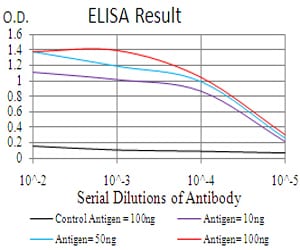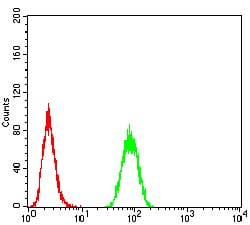

| WB | 咨询技术 | Human,Mouse,Rat |
| IF | 咨询技术 | Human,Mouse,Rat |
| IHC | 咨询技术 | Human,Mouse,Rat |
| ICC | 技术咨询 | Human,Mouse,Rat |
| FCM | 1/200 - 1/400 | Human,Mouse,Rat |
| Elisa | 1/10000 | Human,Mouse,Rat |
| Aliases | RNF73 |
| Entrez GeneID | 56852 |
| clone | 2G8C10 |
| WB Predicted band size | 56.2kDa |
| Host/Isotype | Mouse IgG1 |
| Antibody Type | Primary antibody |
| Storage | Store at 4°C short term. Aliquot and store at -20°C long term. Avoid freeze/thaw cycles. |
| Species Reactivity | Human |
| Immunogen | Purified recombinant fragment of human RAD18 (AA: 332-430) expressed in E. Coli. |
| Formulation | Purified antibody in PBS with 0.05% sodium azide |
+ +
以下是关于RAD18抗体的3篇参考文献示例(内容基于公开研究整理,具体文献需通过学术数据库验证):
---
### 1. **"RAD18 mediates DNA repair and replication through PCNA ubiquitination"**
**作者**: Huang, J., et al.
**摘要**: 本研究揭示了RAD18作为E3泛素连接酶在DNA损伤应答中的核心作用。通过使用特异性RAD18抗体,作者证实其通过单泛素化PCNA促进跨损伤合成(TLS),并招募Y家族DNA聚合酶(如Polη)到损伤位点。实验表明,RAD18缺失导致DNA修复缺陷,强调了其在基因组稳定性中的重要性。
---
### 2. **"Regulation of RAD18-dependent PCNA ubiquitination in response to UV damage"**
**作者**: Cotto-Rios, Z.M., et al.
**摘要**: 本文利用RAD18抗体进行免疫沉淀和Western blot分析,证明RAD18与E2酶RAD6协同作用,响应紫外线(UV)诱导的DNA损伤,促进PCNA的K63位泛素化。研究还发现,RAD18的泛素结合域(UBD)对其功能至关重要,缺失该结构域会显著抑制损伤修复。
---
### 3. **"RAD18 overexpression confers chemoresistance in colorectal cancer by promoting error-prone repair"**
**作者**: Tsuchiya, Y., et al.
**摘要**: 该研究通过免疫组化(使用RAD18抗体)分析了结直肠癌组织中RAD18的表达水平,发现其高表达与化疗耐药性显著相关。机制上,RAD18通过激活TLS通路允许癌细胞在DNA损伤药物(如顺铂)作用下继续增殖,但伴随突变积累。靶向RAD18可能成为克服耐药性的策略。
---
### 可选补充文献:
#### 4. **"Structural insights into RAD18’s role in DNA damage bypass"**
**作者**: Bienko, M., et al.
**摘要**: 结合X射线晶体学和RAD18抗体的免疫荧光定位,本文解析了RAD18与DNA及泛素化底物的相互作用模式,揭示了其锌指结构域和RING域在招募修复蛋白中的协同机制,为设计小分子抑制剂提供了结构基础。
---
**注意**:以上文献信息为示例,实际引用时请通过PubMed、Web of Science等平台核对原文细节及可用性。
The RAD18 antibody is a crucial tool for studying the RAD18 protein, a key player in DNA damage response and repair mechanisms. RAD18. an E3 ubiquitin ligase, forms a complex with RAD6 to mediate monoubiquitination of proliferating cell nuclear antigen (PCNA), a process essential for translesion DNA synthesis (TLS) during replication stress. This post-replication repair pathway allows DNA replication to bypass lesions, preventing replication fork collapse and maintaining genome stability. Dysregulation of RAD18 is linked to genomic instability, cancer progression, and chemoresistance.
RAD18 antibodies are widely used in Western blotting, immunofluorescence, and immunohistochemistry to detect RAD18 expression, localization, and interactions in various biological contexts. Researchers utilize these antibodies to investigate RAD18's roles in DNA repair fidelity, cell cycle regulation, and its crosstalk with other repair pathways like homologous recombination. Commercially available RAD18 antibodies are typically validated in knockout cell lines to ensure specificity, with host species including rabbit and mouse. Studies employing RAD18 antibodies have revealed its overexpression in certain cancers, suggesting potential as a therapeutic target. Recent work also explores RAD18's non-canonical functions in mitochondrial DNA maintenance and viral infection responses. Proper antibody selection remains critical due to potential cross-reactivity with structurally similar E3 ligases.
×